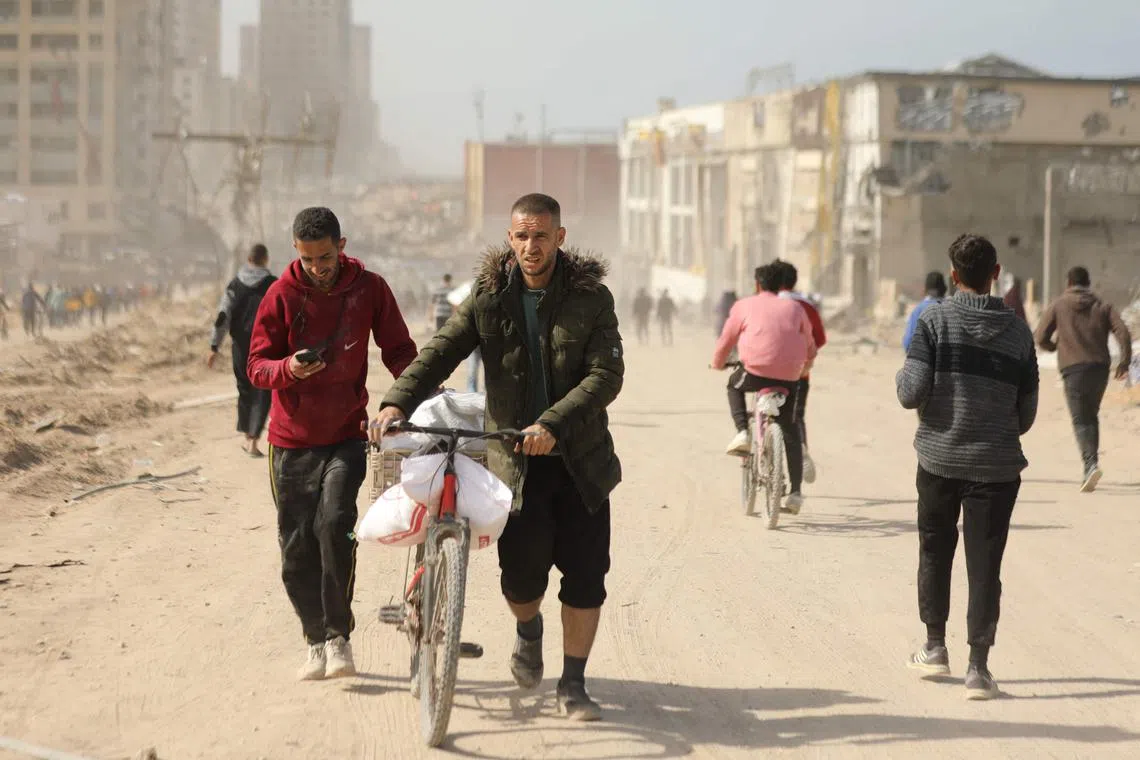UN to test Israeli military road to get aid to Gaza’s north
Sign up now: Get ST's newsletters delivered to your inbox

Palestinians transporting bags of flour as humanitarian aid arrives in Gaza City on March 6.
PHOTO: AFP
Follow topic:
UNITED NATIONS – The United Nations would on March 7 assess how it can use an Israeli military road bordering the Gaza Strip to deliver aid to hundreds of thousands of desperate civilians in the north of the Palestinian enclave, a senior UN aid official said.
The UN has warned that at least 576,000 people in Gaza – one quarter of the population – are on the brink of famine.
Mr Jamie McGoldrick, UN aid coordinator for the occupied Palestinian territories, said the UN had been pushing Israel for weeks to use the Gaza border fence road and had received much more cooperation from Israel in the past week.
Palestinian officials say more than 100 people were killed on Feb 29
Israel’s military, which had been overseeing the private aid deliveries, said most of them died in a stampede.
“Since the incident last week, I think Israel saw quite clearly how difficult it is to deliver assistance,” Mr McGoldrick told reporters, adding that the UN had seen “much more cooperation from Israel as a result of that realisation”.
Aid can currently reach Gaza in the south via the Rafah crossing from Egypt and Kerem Shalom from Israel. Mr McGoldrick said the plan was for aid convoys to be inspected at those crossings, then escorted through Israeli territory along a military road to the Israeli border village of Beeri.
“Once we go inside Gaza, we will be then left to go on our own,” he said, adding that the UN would do an assessment of the possible new route on March 7 to check the state of the roads within Gaza to ensure there is no unexploded ordnance and to identify suitable distribution points for the aid.
Road versus air
Mr McGoldrick said that using this route to reach northern Gaza allowed aid convoys to avoid congested roads and insecurity within the enclave.
The UN World Food Programme paused its deliveries to northern Gaza on Feb 20 due to safety concerns, with its convoys exposed to attacks by hungry mobs.
Mr McGoldrick added that other avenues for aid – including Israel’s Ashdod port and air drops by the United States and Jordan – were “helpful but these are not going to address the significant needs, which can be done only by road transport”.
The UN Palestinian refugee agency UNRWA has said that during February, an average of nearly 97 lorries were able to enter Gaza each day, compared with about 150 lorries a day in January – well below a target of 500 daily.
Israeli government spokesman Eylon Levy on March 6 said there are no limits on the amount of aid that can enter Gaza, urging donors: “Send the aid, we’ll get it in.
“Israel’s crossings are able to scan 44 trucks an hour combined. The problem is distribution. The UN is struggling to distribute aid at the pace that Israel is letting it in.”
He added that Israel was “working on new strategies together with the private sector inside the Gaza Strip to get aid to the people who need (it)” and that on March 6, more than a dozen food lorries travelled to northern Gaza in coordination with Israel.
The war in Gaza began when Hamas fighters attacked Israel on Oct 7
Israel retaliated by initially imposing a “total siege” on Gaza and launching an air and ground assault that has since killed around 30,000 Palestinians, the health authorities in the Hamas-run enclave say. REUTERS

